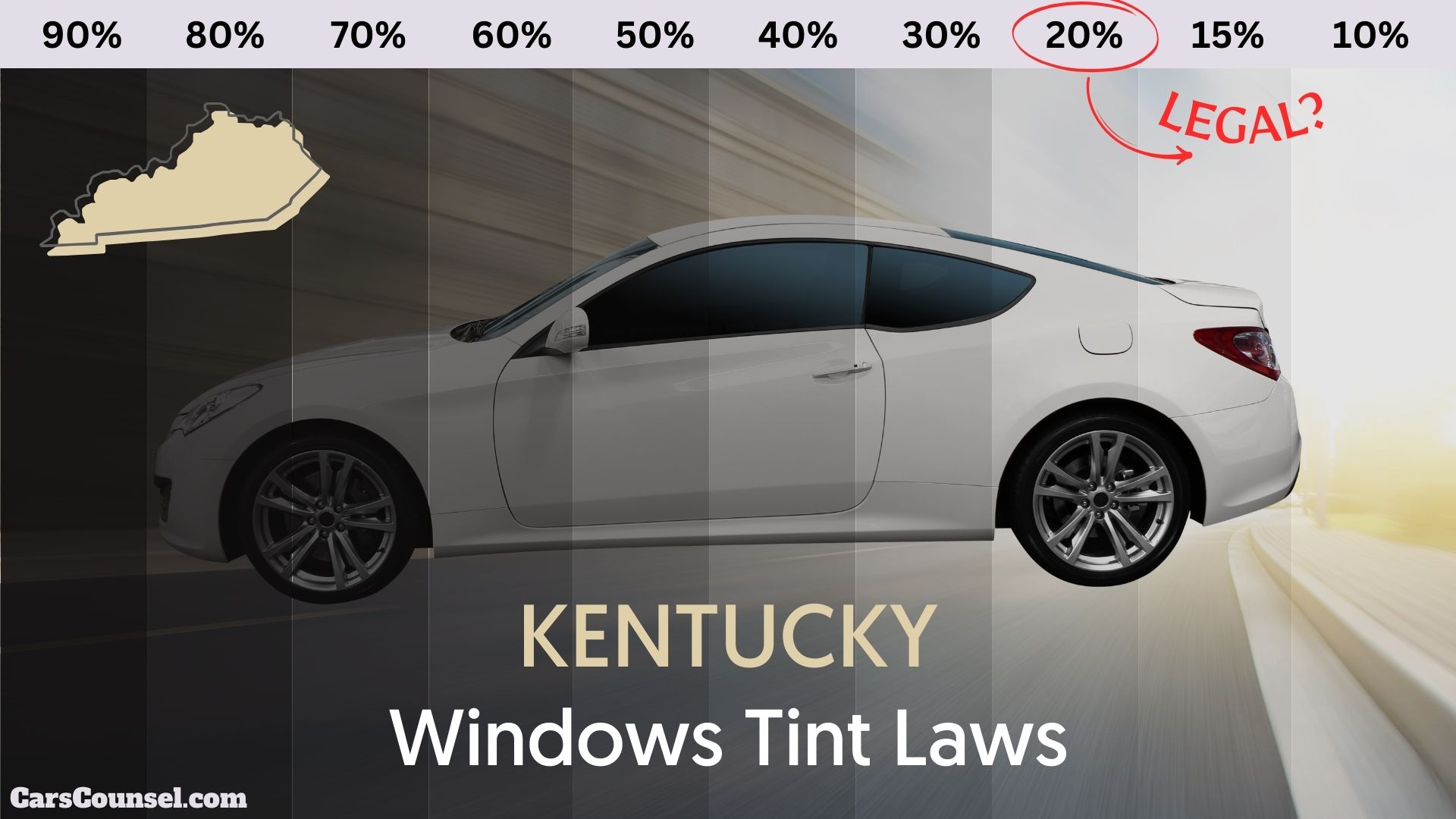Imagine driving down a Kentucky highway on a sunny day, only to be pulled over by a state trooper who’s not impressed with your vehicle’s tinted windows. As it turns out, understanding Kentucky’s window tinting laws is vital to avoid getting into trouble.
You might think you’re safe, but the truth is, the state has specific regulations regarding window darkness, reflection, and glare. For instance, did you know that your windshield must allow at least 90% of visible light transmission? There’s more to it than that, and it’s essential to know the details to avoid fines, misdemeanor charges, or even worse.

Quick Navigation
Window Tint Darkness Regulations
When it pertains to window tinting, one of the most critical factors to ponder is the level of darkness permitted by law.
In Kentucky, window tint laws dictate that the windshield above the manufacturer’s AS-1 line must allow at least 90% of visible light transmission. For front side windows, the light transmittance must be no less than 35%.
You should guarantee that your window tint complies with these rules to avoid penalties. The percentage of visible light allowed to pass through the tint determines the level of darkness.
Kentucky window tint regulations are in place to certify safe driving conditions. Remember, it’s essential to understand the window tint rules and regulations to avoid any issues with the law.
[carscounsel_tint_calculator show_state=”true” default_state=”KY”]
Reflection and Glare Restrictions
Kentucky’s window tint laws also establish reflection and glare restrictions to guarantee safe driving conditions. You should be aware of these regulations to avoid any legal issues. The state has set specific standards for window tint reflection to ensure that your vehicle’s windows don’t pose a safety risk to you or other drivers.
| Window Location | Reflection Limit |
|---|---|
| Front windshield | No metallic or mirrored finishes |
| Front side windows | No more than 25% reflective |
| Rear window | No more than 35% reflective |
Vehicle Type and Tint Exceptions
In accordance with Kentucky’s window tint laws, certain vehicle types and tint exceptions are exempt from or subject to specific regulations.
You should be aware of these exceptions to guarantee compliance with the law.
- Medical Exemptions: You may be eligible for a medical exemption from the window tinting laws if you have a medical condition that requires a darker tint. You’ll need to obtain a tint variance from the Kentucky Transportation Cabinet.
- Manufacturers AS-1 Line: Vehicles with a manufacturer’s AS-1 line on the windshield can have a darker tint on the top portion of the windshield.
- Rear Window and Door Jamb: Some vehicle types, such as trucks and vans, can have a darker tint on the rear window and door jamb.
Seller and Installer Requirements
As you prepare to purchase or install window tints, it’s essential to understand the seller and installer requirements, which are critical components of Kentucky’s window tint laws.
You should only buy window films from manufacturers that certify their products meet Kentucky’s legal tinting standards. The seller must provide a sticker that identifies the film as compliant with Kentucky law.
When selecting an installer, guarantee they’re familiar with Kentucky’s window tint regulations and can identify the legal tinting levels for your vehicle. Remember, only installers who use certified window films can guarantee compliance with Kentucky law.
Additionally, the installer is required to provide you with a sticker that confirms the film meets Kentucky’s standards.
Penalties for Non-Compliance
One hundred fifty dollars – that’s the minimum fine you’ll face if you’re caught driving a vehicle with illegally tinted windows in Kentucky.
If you’re found guilty of non-compliance, you could be charged with a class B misdemeanor, which can lead to more severe penalties. According to the Kentucky Revised Statutes, law enforcement officers can issue citations to drivers who fail to comply with the state’s window tinting rules and regulations.
- Fines: The minimum fine for illegal window tinting is $150, but it can increase depending on the circumstances.
- Misdemeanor charges: You could be charged with a class B misdemeanor, which can lead to more severe penalties, including jail time.
- Certification issues: If you’re a seller or installer, non-compliance can put your certification at risk, potentially impacting your business.
Tint Law References
Maine Statutes Title 29A section 1916: Reflective and tinted glass
Car Window Tinting Laws By State
Click on the state you’re interested in for a complete guide to its tint laws and regulations. If you spot any errors, let us know through our contact page.
| State | Front Side Windows | Back Side Windows | Rear Windows | Windshield |
|---|---|---|---|---|
| Alabama | 32% | 32% | 32% | 6 inches |
| Alaska | 70% | 40% | 30% | 5 inches |
| Arizona | 33% | ANY | ANY | tinting allowed to the top of the manufacturer’s as-1 line |
| Arkansas | 25% | 25% | 10% | 5 inches |
| California | 70% | ANY | ANY | 4 inches |
| Colorado | 27% | 27% | 27% | 4 inches |
| Connecticut | 35% | 35% | ANY | non-reflective tint above the as-1 line top 6 inches |
| Delaware | 70% | ANY | ANY | non-reflective tint above the as-1 line top 6 inches |
| Florida | 28% | 15% | 15% | non-reflective tint above the as-1 line |
| Georgia | 32% | 32% | 32% | 6 inches |
| Hawaii | 35% | 35% | 35% | Non-reflective tint is allowed on the top 4 inches of the windshield |
| Idaho | 35% | 20% | 20% | non-reflective tint above the as-1 line |
| Illinois | 35% | 35% | 35% | 6 inches |
| Indiana | 30% | 30% | 30% | non-reflective tint above the as-1 line |
| Iowa | 70% | ANY | ANY | non-reflective tint above the as-1 line |
| Kansas | 35% | 35% | 35% | non-reflective tint above the as-1 line |
| Kentucky | 35% | 18% | 18% | non-reflective tint above the as-1 line |
| Louisiana | 40% | 25% | 12% | non-reflective tint above the as-1 line top 6 inches |
| Maine | 35% | 35% | 35% | top 4 inches |
| Maryland | 35% | 35% | 35% | top 5 inches |
| Massachusetts | 35% | 35% | 35% | top 6 inches |
| Michigan | 35% | ANY | ANY | top4 inches |
| Minnesota | 50% | 50% | 50% | Top 6 inches |
| Mississippi | 28% | 28% | 28% | non-reflective tint above the as-1 line top 5 inches |
| Missouri | 35% | ANY | ANY | non-reflective tint above the as-1 line top 6 inches |
| Montana | 24% | 14% | 14% | non-reflective tint above the as-1 line top 6 inches |
| Nebraska | 24% | 20% | 20% | top 6 inches or as-1 line, whichever comes first |
| Nevada | 35% | ANY | ANY | non-reflective tint above the as-1 line top 6 inches |
| New Hampshire | 35% | 35% | 35% | Allowed for the manufacturer’s AS-1 line |
| New Jersey | Illegal | ANY | ANY | Top 6 inches |
| New Mexico | 20% | 20% | 20% | 5 inches or as-1 line, whichever comes first |
| New York | 70% | 70% | 70% | top 6 inches |
| North Carolina | 35% | 35% | 35% | non-reflective tint above the as-1 line top 6 inches |
| North Dakota | 50% | ANY | ANY | Top 6 inches |
| Ohio | 50% | ANY | ANY | Top 5 inches |
| Oklahoma | 25% | ANY | ANY | 5 inches or as-1 line, whichever comes first |
| Oregon | 35% | 35% | 35% | Top 6 inches |
| Pennsylvania | 70% | 70% | 70% | Top 3 inches |
| Rhode Island | 70% | 35% | 35% | non-reflective tint above the as-1 line top 6 inches |
| South Carolina | 27% | 27% | 27% | non-reflective tint above the as-1 line top 6 inches |
| South Dakota | 35% | 20% | 20% | non-reflective tint above the as-1 line top 6 inches |
| Tennessee | 35% | 35% | 35% | non-reflective tint above the as-1 line top 6 inches |
| Texas | 25% | 25% | 25% | 5 inches or as-1 line, whichever comes first |
| Utah | 43% | ANY | ANY | non-reflective tint above the as-1 line top 4 inches |
| Vermont | 70% | ANY | ANY | ILLEGAL |
| Virginia | 50% | 35% | 35% | non-reflective tint above the as-1 line top 6 inches |
| Washington | 24% | 24% | 24% | Top 6 inches |
| West Virginia | 35% | 35% | 35% | Top 5 inches |
| Wisconsin | 50% | 35% | 35% | non-reflective tint above the as-1 line top 6 inches |
| Wyoming | 28% | 28% | 28% | Top 5 inches or as-1 line, whichever comes first |

